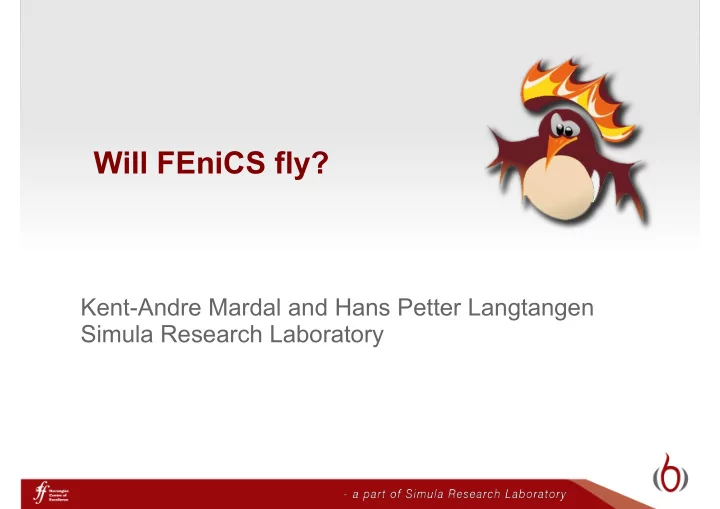

Will FEniCS fly? Kent-Andre Mardal and Hans Petter Langtangen Simula Research Laboratory
Background 2009 2010 2012
Background 2009 2010 2012
Numerical model Classification of people: P (potential users that have never heard about FEniCS) I (interested users that are aware of FEniCS) E (evaluators testing FEniCS) U (established users) N (non-users – people that are aware of FEniCS but chose not to use it) P, I, E, U, N are functions of time
The potentials A meeting between a potential user (P) and either a user (U), enthusiast (E), or interested (I) likely turns the P to I. The meeting is modeled as: Marketing (announcement) on internet is modeled as Tutorials turn a fixed small number T of potentials to evaluators Summing up:
The interested The previously mentioned meeting/product term that was removed from potentials (P) is turned to interested (I) And the web announcements result in interested Furthermore, there is a leakage to evaluators (E) and non-users (N). And we end up with:
The Evaluators We remember the leakage from the interested and tutorials, both increasing the number of evaluators (E) There is a leakage to the users (U) and non-users (N), which we assume is proportional to the level of documentation (1 = excellent) Summing up:
The users and non-users Users get an influx from the evaluators (proportional to D) but there is a leakage to non-users. Even with perfect documentation, there will be a leakage due to e.g. changed life situations for the users, so we end up with Mass conservation leads to the following equation for non-users:
Complete model Describe N
Different scenarios Isogeometric analysis FEniCS software 2005 2003
Tom Hughes
The model Describe N
Parameter identification Initial conditions: P(0) = 50 000, I(0) = 100, E(0) = 10, U(0) = 50, N(0) = 30 000 Assume that in a week, 50 FEniCS users generate interest among 10 people in a population of 50,000. Hence, Or Further:
Parameter identification Concerning the web-announcement: Mu and beta are set such that it takes a week to reduce the effect of the announcement by a factor 0.9 and the announcement reach 10% of P. And we may vary the number of announcements. Assuming that a fixed number of people at the tutorials (T=50):
Parameter identification We assume that 1% of the interested try to install the software, which is easy due to J Ring, during one week and become evaluators: We assume that it takes four years to forget bad experiences (this is typically e.g. in finance). Hence, We assume that within one month, 10% of the evaluators become users and 10% decide that FEniCS is not suitable for their problem, i.e.,
Documentation
Web announcement
Tutorials
No marketing
Adding web announcements
Web announcments and tutorials
Web announcements and tutorials- no Ring effect
Aggressive marketing – Tom Hughes
Long run – no marketing
Long run – keeping users
Conclusion: FEniCS will fly FEniCS VS Isogeometric 1 0 (in the long run)
Recommend
More recommend